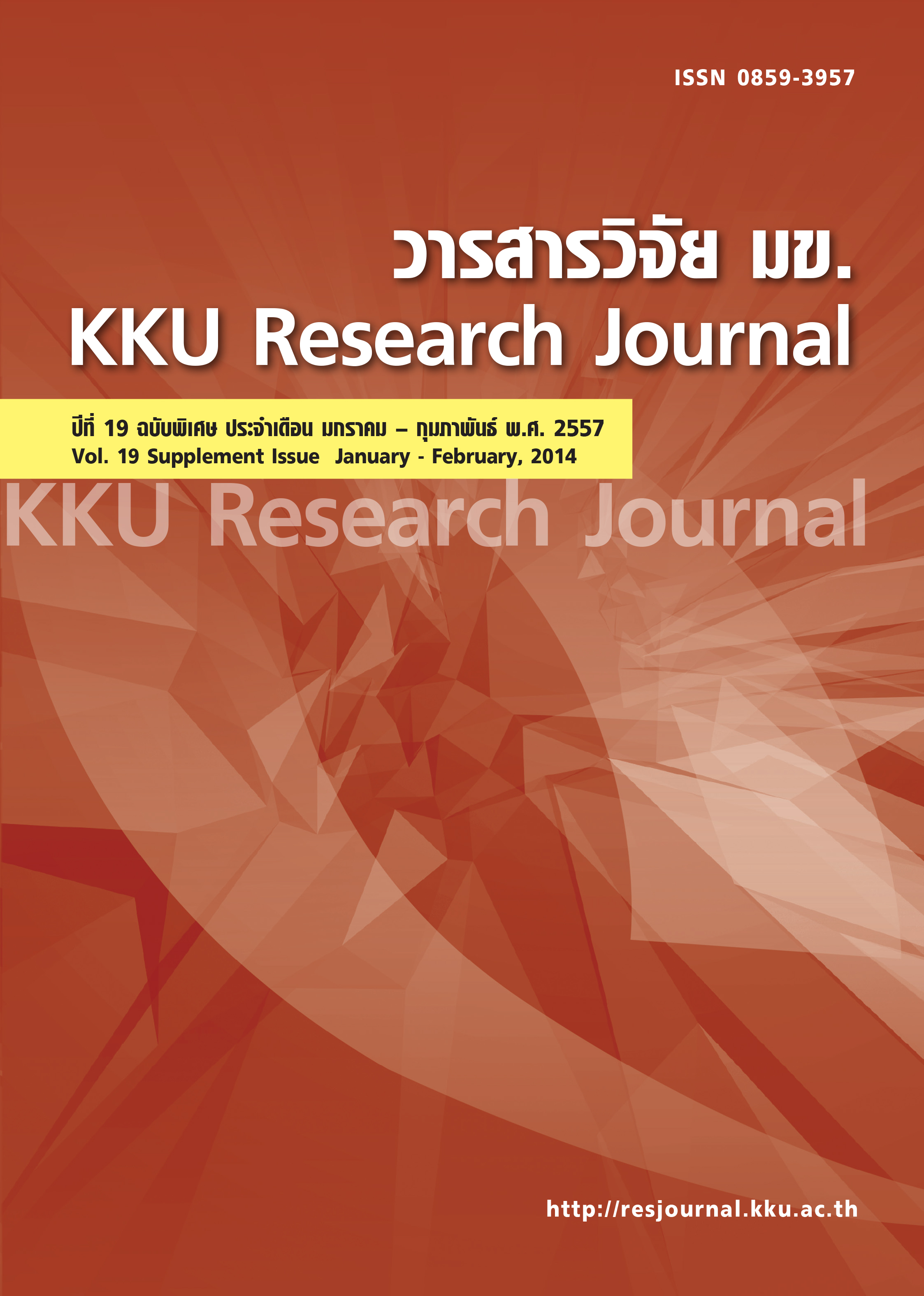Diversity of lactic acid bacteria in Thai fermented pork (nham) during fermentation assessed by denaturing gradient gel electrophoresis
Main Article Content
Abstract
This work presents the study of lactic acid bacteria (LAB) diversity in Thai fermented pork (nham) at different time points of the fermentation by denaturing gradient gel electrophoresis (DGGE) technique. Total DNA extracted from two nham samples, fermented with and without Lactobacillus plantarum starter culture, were amplified using primers targeted at V3 region of the 16S rRNA gene of bacteria. DNA bands appeared on DGGE gels were cloned and sequenced for species identification. The results showed that the LAB species in both nham samples at the beginning of fermentation was diverse and at least 15 species were detected. The number of species was then reduced dramatically during the first 2 days of fermentation. Two main species, i.e. Lactococcus garvieae and Lactococcus lactis were found from day 2 to day 15. In nham fermented with starter culture, the DGGE band corresponding to the Lb. plantarum was evident from the beginning to the end of the test period. However, in nham without starter culture, although no Lb. plantarum was added and no corresponding band appeared at the beginning of fermentation, the band gradually appeared as faint band on day 3 and increased in intensity as fermentation progressed. Similar pattern was also observed on the band corresponding to Pediococcus pentosaceus. This phenomenon suggested that Lb. plantarum and P. pentosaceus can be established successfully and may play an important role in nham fermentation system. This study also reported co-migration of different DNA species to the same DGGE-band position as well as fragments with the same DNA sequence may also migrated to different position on the DGGE gel. Therefore, the number of DGGE bands could not be used to identify the number of bacterial species in the sample accurately
Article Details
References
[2] Tanasupawat S, Komagata K. Lactic acid bacteria in fermented foods in Thailand. World J Microbiol Biotechnol. 1995;11(3):253-6.
[3] Ercolini D. PCR-DGGE fingerprinting: novel strategies for detection of microbes in food. J Microbiol Methods. 2004;56(3):297-314.
[4] Fischer SG, Lerman LS. DNA fragments differing by single base-pair substitutions are separated in denaturing gradient gels: correspondence with melting theory. Proc Natl Acad Sci USA. 1983;80(6):1579-83.
[5] Endo A, Okada S. Monitoring the lactic acid bacterial diversity during shochu fermentation by PCRdenaturing gradient gel electrophoresis. J Biosci Bioeng. 2005;99(3):216-21
[6] Walter J, Hertel C, Tannock GW, Lis CM, Munro K, Hammes WP. Detection of Lactobacillus, Pediococcus, Leuconostoc, and Weissella species in human feces by using group-specific PCR primers and denaturing gradient gel electrophoresis. Applied and environmental microbiology. 2001;67(6):2578-85.
[7] Tran KTM, May BK, Smooker PM, Van TTH, Coloe PJ. Distribution and genetic diversity of lactic acid bacteria from traditional fermented sausage. Food Research International. 2011;44(1):338-44.
[8] Nguyen DTL, Van Hoorde K, Cnockaert M, De Brandt E, De Bruyne K, Le BT, et al. A culturedependent and -independent approach for the identification of lactic acid bacteria associated with the production of nem chua, a Vietnamese fermented meat product. Food Research International. 2013;50(1):232-40.
[9] Tu R-J, Wu H-Y, Lock Y-S, Chen M-J. Evaluation of microbial dynamics during the ripening of a traditional Taiwanese naturally fermented ham. Food Microbiology. 2010;27(4):460-7.
[10] Danilovic B, Jokovic N, Petrovic L, Veljovic K, Tolinacki M, Savic D. The characterisation of lactic acid bacteria during the fermentation of an artisan Serbian sausage (Petrovska Klobasa). Meat Sci. 2011;88(4):668-74.
[11] Fonseca S, Cachaldora A, Gamez M, Franco I, Carballo J. Monitoring the bacterial population dynamics during the ripening of Galician chorizo, a traditional dry fermented Spanish sausage. Food Microbiology. 2013;33(1):77-84.
[12] Green SJ, Leigh MB, Neufeld JD. Denaturing Gradient Gel Electrophoresis (DGGE) for Microbial Community Analysis. In: Timmis K, editor. Handbook of Hydrocarbon and Lipid Microbiology: Springer Berlin Heidelberg; 2010. p. 4137-58.


